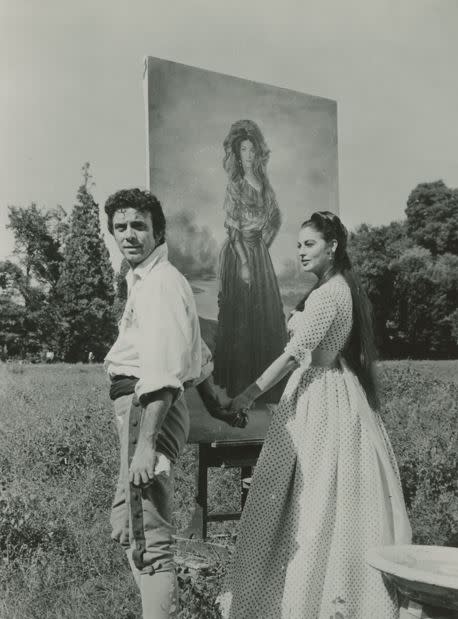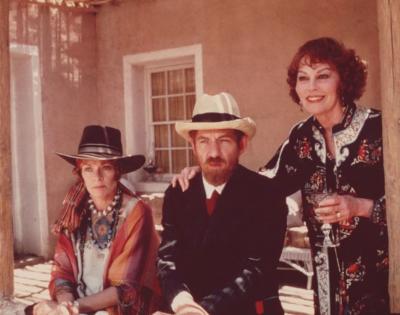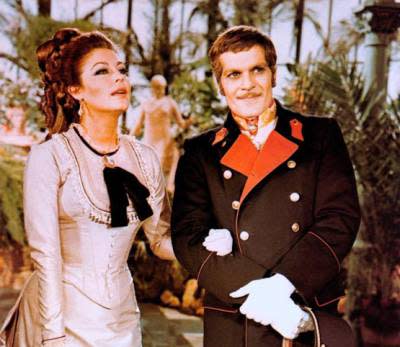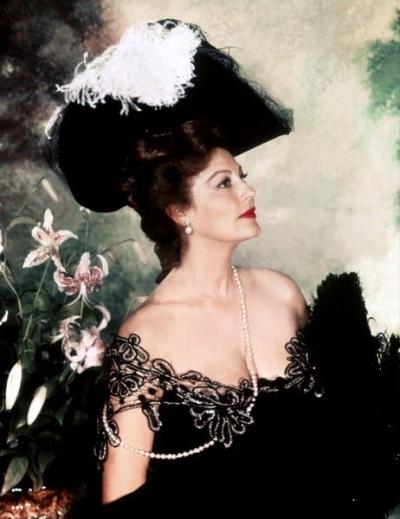During the course of her five-decade career, Ava Gardner starred in a variety of genres, working in projects as diverse as historical epics, supernatural films, political thrillers, disaster movies, romances, musicals, and everything in between. She appeared in two biopics or biographical films, defined as movies dramatizing the life of a particular person, typically a public or historical figure. Ava Gardner also portrayed real-life people in several productions based on true events. These biographical and historical films reflect her range as an actor as well as the breadth of characters and stories she brought to life on screen.
The Naked Maja (1958) – Biopic Film about Francisco Goya and his relationship with the Duchess of Alba
Francisco José de Goya y Lucientes (1746-1828), often described as one of the most important Spanish artists of his time, is considered the last of the Old Masters by art historians. One of his most famous paintings is La maja desnuda (The naked maja). Painted in the late 1790s, some say the subject of the painting is María del Pilar Teresa Cayetana de Silva y Álvarez de Toledo, 13th Duchess of Alba (1763-1802). Goya, who was rumored to have an intimate relationship with the Duchess, officially painted her portrait twice. In the film The Naked Maja, Ava Gardner portrays the titular character of the Duchess of Alba while Anthony Franciosa played Goya. The movie depicts the alleged romance between the famed Spanish painter and the Duchess and the creation of the once infamous painting.

Ava Gardner as the Duchess of Alba in The Naked Maja.
According to the memoir Living With Miss G written by Ava’s close friend and personal assistant Mearene (Rene) Jordan, Ava was not only familiar with Goya’s work but was a great admirer of the painter when she was assigned the film role by her home studio of MGM. According to Rene: “Prior to the beginning of this picture Miss G and I were quite certain we were authorities on the life and times of the great Spanish painter Francisco Goya. I do not suppose the art world would have confirmed this supposition, but we didn’t care about that. We adored Goya. We’d become familiar with his work during our first Spanish period when we spent weeks constantly returning to the Prado, prowling its corridors with our eyes out on beanstalks. Francisco Goya gripped the imagination and the hearts of us both…[and] his great canvases of the Spanish Royals stopped us in our tracks.”
While a personal fan of the Spanish painter’s artwork, Ava was rather disappointed with the finished film, and, ultimately, she did not care for the studio’s overall approach to telling Goya’s story. In her autobiography Ava: My Story, Ava wrote this assessment of the biopic, “The Naked Maja, a better title than a film, was not my most memorable effort: a rather tame biography of the great Spanish artist Francisco Goya.” Ava mostly remembered the production for two important reasons – the project was her last under her MGM contract, and because she loved the movie’s cinematography. She later recalled, “The Naked Maja stays in my memory for two reasons. One is that it was the first time I worked with one of the greatest cameramen I've ever known, Giuseppe Rotunno, whose beautiful colors flooded the whole movie. More important, however, The Naked Maja was the last picture I had to do on my damn MGM contract. When it was over I was free at last free to choose my own projects, free to command the kinds of fees I was worth. It was about time.”

Anthony Franciosa as Goya and Ava Gardner as the Duchess of Alba in The Naked Maja.
The Naked Maja was filmed in Italy because the Alba family still held great power and prestige in Spain and disapproved of the production. In terms of accuracy, the final film departed from history in several ways. Despite persistent rumors, no actual historical evidence exists, apart from the portraits he painted of her, that firmly confirms Goya and the Duchess of Alba were romantically involved. Art historians dispute the identity of the subject of La maja desnuda – with some believing the portrait is of the Duchess and others believing it to be either a woman named Pepita Tudó or a composite image of several women. Tudó was the mistress of the Spanish prime minister Manuel Godoy who commissioned both La maja desnuda and La maja vestida, a version of the painting in which the same subject appears clothed. Additionally, the film portrays the death of the Duchess as being caused by poisoning, a piece of gossip that has since been proven false. The film also has several timeline errors. Goya is depicted as young, healthy, and virile in the movie; however, he would have been nearly 50 years old at the time he would have met and painted the Duchess. In real life he was also dealing with deafness which was the result of an illness.
The biopic also includes numerous other inconsistencies and departures from history. According to Living With Miss G, Ava took note of several of the ways in which the film digressed from the real story. Rene remembered Ava saying: “I guess you could conclude, Rene, that we tampered with the history of poor old Francisco in quite a significant way.”
The film’s reviews were almost all negative. The New York Times called the film “an almost incredible hodge-podge of childish notions concerning the life and times of Francisco Goya.” The reviewer argued that the film “reduces the epic spiritual struggles of Goya to a foolish fable about his on-again off-again love for the Duchess of Alba…Everything has been reduced to a cliché, safe and obvious enough to serve as filler and pretense for the series of fabricated spectacles that make up the substance of the film.”
Another reviewer wrote, “this production just drags on, a maze of pompous dialog and muddled emotions that seldom ring true.” Another critic said: “What atrocities they have not committed on history, writers Norman Corwin and Giorgio Prosperi have dealt out to the script.”
For more background on the film, check out its listing in the American Film Institute’s catalog.
Read the full New York Times review quoted above here.
Priest of Love (1981) – Biopic Film about writer D.H. Lawrence and his wife Frieda
In Priest of Love, the 1981 biographical film about British writer D.H. Lawrence (1885-1930), Ava Gardner plays the secondary role of real-life American art patron Mabel Dodge Luhan (1879-1962). Luhan moved to New Mexico in 1917 and used her immense wealth to establish a literary and art colony in the community of Taos.

Ava Gardner as Mabel Dodge Luhan in Priest of Love.
D.H. Lawrence’s writings were regularly met with censorship and suppression, especially in his native country of England. The contemporary literary establishment in his time disapproved of Lawrence’s exploration of sexuality in his writings, including same-sex relationships, and deemed his work obscene. The film Priest of Love focuses on Lawrence’s relationship with his wife Frieda and particularly their life and travels after the publication of his book The Rainbow (1915). Lawrence and Frieda, who was German, were regarded with suspicion in Britain during World War I. Lawrence’s anti-militaristic views on war contributed to the British government’s hostile treatment of the couple, and this may also have been the reason The Rainbow was censored and investigated for obscenity.
In 1917, Lawrence was forced to leave his home in Cornwall under the Defence of the Realm Act. From that point until after the war ended in 1919, Lawrence and Frieda moved several times. In 1919, they embarked on what Lawrence called his “savage pilgrimage” – traveling to Australia, Italy, the United States, Mexico, Sri Lanka, and France. The couple’s trips after WWI are depicted in the film Priest of Love, including the two-year period in which they lived at the Taos colony in New Mexico and traveled to Mexico several times.
Mabel Dodge Luhan, who Ava portrays in the film, invited the Lawrences to stay at her Taos colony. In 1924, Luhan traded the 160-acre Kiowa Ranch in the Taos art colony for the manuscript for Lawrence’s novel Sons and Lovers (1913). This trade is depicted in the film, which goes on to follow the writer’s life, writings, and travels leading up to his return to Europe and his death. Lawrence died in France from tuberculosis in 1930. The film, which was based on the biography entitled The Priest of Love: A Life of D.H. Lawrence by Harry T. Moore, is considered to be historically accurate overall.

Janet Suzman as Frieda Lawrence, Ian McKellen as D.H. Lawrence, and Ava Gardner as Mabel Dodge Luhan in Priest of Love.
Priest of Love was one of the last films Ava Gardner made before her career shifted into television movies and miniseries. The role of D.H. Lawrence was played by Ian McKellen, and Janet Suzman portrayed Lawrence’s wife Frieda. In a 1999 interview, McKellen said of the film: "Everything about this biopic aimed for authenticity – we filmed on many of the actual locations that were visited by the Lawrences and their friends and most of the cast managed to look not unlike their originals. At our first meeting, Christopher Miles was very taken that, like D.H. Lawrence, I have blue eyes. I also shared his oval-shaped face…The true authenticity was in the dialogue invented by Alan Plater, and based on factual episodes culled from Harry T. Moore’s biography 'A Priest of Love.' At the pre-filming cast party in Mayfair at the home of Stanley Seger, the film’s financer, I asked Plater, sitting quietly in a corner, what Lawrence would do at such a gathering. 'Oh, just sit quietly in a corner,' he said."
McKellen also remembered meeting and working with Ava Gardner on the film: “I flew out alone to Oaxaca in Mexico, our first location, and was shown up to my hotel suite overlooking the valley surrounded by a distant mountain range. The dusk was pierced by lights twinkling in the town where D.H. Lawrence had stayed and written. Through the fronds of the palms on a level with my verandah, the swimming pool reflected the fading blue of the sky. A lone bather in a bright green one-piece was breast-stroking in my direction. She waved. 'Hello Ian!' It was Ava Gardner and I felt I was in Hollywood. We had met at Stanley’s party for the cast two weeks earlier. She wore little makeup and her soft, light brown hair fell wispily against her pale celebrated cheekbones…Christopher Miles told me she was tempted back to work by Janet Suzman and me, whom she knew by reputation rather than by having seen our work. Certainly she never passed a compliment and although she was intimate in the way actors need to be if they are to act convincingly together, we never got to know each other well.”
The film received mixed reception from critics. Roger Ebert’s 1981 review lamented that “In ‘Priest of Love,’ we see many of the actual places where Lawrence lived, and the homes he occupied there, but we don't learn much about the man.” Ebert praised McKellen’s writing while also noting that he was limited by the script. Of Ava Gardner’s role in the film he said: “It is fascinating to see Ava Gardner playing Dodge; at 60, Gardner is beautiful, mysterious and just right for this role. But by then we've lost interest in the movie.”
The New York Times likewise found many shortcomings in the film, calling it a “foolish film” that is “less capable of exploring the relationship between Frieda and Lawrence than in giving us its itinerary.”
However, the Washington Post praised the film overall: Priest of Love is an unprecedented delight: a movie biography of a great writer that blends devotion and historical accuracy with tart, and ultimately stirring, character delineation. I doubt that anyone has ever filmed a more intelligent or satisfying literary bio.” The reviewer also remarked that Ava Gardner “impersonated” Mabel Dodge Luhan “with endearing noblesse.”
The film was re-edited and re-released in 1985. Critics praised the updated film which had a few additions but mostly reflected several key cuts. The Daily Telegraph review asked, “Can a film, only slightly faulted, be redeemed by re-editing?” And answered: “it certainly has happened now... with some new material by Mr. Miles to give a shorter, sharper, more chronological account...” The Times review of the 1985 release stated that the film was “Honourable and absorbing, with vivid, rounded, warty characterisations of Lawrence and Frieda by Ian McKellen and Janet Suzman, and creditable support by Ava Gardner, John Gielgud, and Penelope Keith.”
Learn more about the film at the below links:
Learn more about D.H. Lawrence’s life here.
Both The Naked Maja and Priest of Love were true biopics. The following two movies are less biographical films and more historical dramas; however, in both productions Ava Gardner portrays real-life people, and the plots are based on real events.
Mayerling (1968)
Ava Gardner portrayed the Empress Elizabeth of the Austrian-Hungarian Empire in Mayerling. The film was based on the real-life Mayerling incident, the events surrounding the deaths of Rudolf, Crown Prince of Austria (1858-1889), and his lover, Mary Freiin von Vetsera (1871-1889) in an apparent murder-suicide pact. Ava’s plays the mother of Rudolf, who was depicted by Omar Sharif.

Ava Gardner and Omar Sharif in Mayerling.
According to Rene in Living With Miss G: “The script was based on a true story. At the end of the last century, Crown Prince Rudolph, played by Omar Sharif, heir to the Austrian Hungarian throne, fell in love with a commoner, Maria Vetsera, played by Catherine Deneuve, even though he was married to Princess Stephanie of Belgium. It was a tragic love story that ended in a suicide pact between the two lovers in a hunting lodge in the forest of Mayerling. As usual, the true story was enhanced and embroidered with fictional incidents such as intrigues at court, plots to free Hungary from Austrian rule, and fierce confrontations between father and son. Emperor Franz Josef, played by James Mason, was a stern, martial figure.”
The Life and Times of Judge Roy Bean (1972)
Ava Gardner appeared in The Life and Times of Judge Roy Bean in a brief, cameo role as Lily Langtry (1853-1929), a British-American socialite and actress. The film starred Paul Newman as Roy Bean (c. 1825-1903) and also featured Ava’s close friend Roddy McDowall. Directed by John Huston, also a dear friend and one of Ava’s favorite directors, the film was a western loosely based on the life of Judge Roy Bean. Bean was a saloon-keeper and Justice of the Peace in Texas. He allegedly held court in his saloon which he named the Jersey Lilly in honor of Lily Langtry.

Portrait of Ava Gardner as Lily Langtry for The Life and Times of Judge Roy Bean.
This post is a contribution to Hometowns to Hollywood's Biopic Blogathon.





